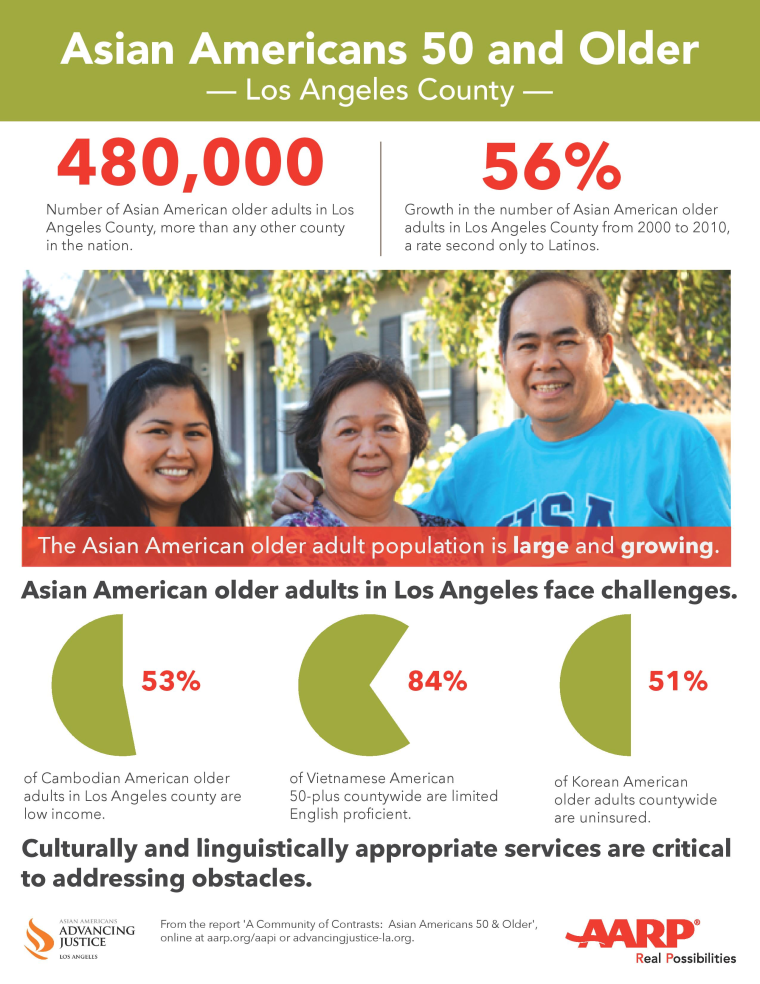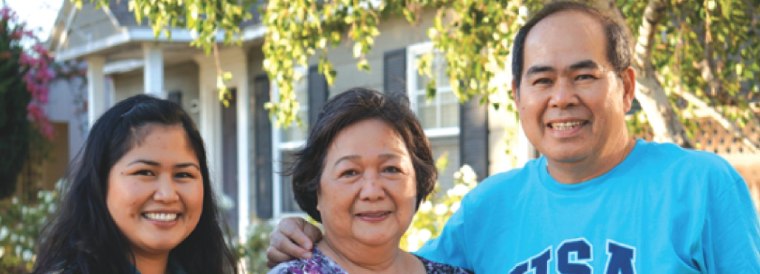The idea of a rapidly growing Asian-American community may invoke images of a booming youthful culture, but in Los Angeles, a new report reveals a graying community that’s less raging and more aging.
Los Angeles County is home to 480,000 Asian-American adults over the age of 50, a number larger than any other county in the nation, according to the findings of a report by the American Association of Retired Persons (AARP) and Asian Americans Advancing Justice | Los Angeles released Wednesday.

The large and growing older Asian-American community in Los Angeles has increased by 56 percent from 2000 to 2010, the report found, a rate second only to Latinos.
“We all know the AAPI population is booming and is the largest, fastest growing, but we always think of it in the aggregate, we don’t zero in on those ages 50-plus,” Daphne Kwok, AARP’s vice president of multicultural leadership told NBC News.
The comprehensive look at LA County, “A Community of Contrasts: Asian Americans 50 and Older,” is based on U.S. Census data and annual California Health Interview Surveys, and breaks down the community to reveal new cultural and linguistic challenges.
While Chinese, Filipino, and Korean Americans are the largest populations, Bangladeshi, Fijian, and Pakistani Americans are the fastest growing, the report found.
RELATED: Asian Americans More Likely to Have Multigenerational Households
The ethnic disaggregation allows for insights often lost in a broad “Asian-American,” or “other” category.
For example, the report found that 53 percent of Cambodian-American adults are low income, 84 percent of Vietnamese Americans have limited English proficiency, and 51 percent of Korean Americans are uninsured.
“These numbers continue to shatter the model minority myth, whether it’s educational attainment, economic attainment, or poverty levels,” Kwok said. “They are extremely important to help us illustrate the tremendous needs of the community.”
The report found that nearly 90 percent of 50-plus Asian Americans in Los Angeles County are immigrants and are more likely to be foreign-born. Given that high percentage, only 79 percent have become U.S. citizens. Older Korean, Thai, and Filipino Americans are least likely to be citizens.
Kwok said some of that can be explained by the boom from the 1965 immigration reforms that allowed for greater immigration from Asia while 15 percent of 50-plus Asian Americans entered in 2000 or later.
The overall effect is that many older adults still have limited English proficiency, including the majority of Cambodian, Vietnamese, Korean, Chinese, and Thai Americans.
It means that the issues of language barriers for newer immigrants at the front end of their American life never go away.
RELATED: Report Exposes Health Coverage Gap Across Asian-American Seniors
Kwok said those barriers contribute to lower educational attainment for some Asian-American groups. For example, only 43 percent of Cambodians 50-plus have a high school degree, a rate lower than any other racial group.
The report found that educational attainment impacts income levels as well. Among those 65 years of age and older, Korean and Cambodian Americans in LA County are more likely than any racial group to have low incomes and live below the poverty line. Because of lower incomes, Asian-American seniors are also the most reliant on Supplemental Security Income, making Social Security an important political topic for Asian Americans.
The spiral continues on with issues on housing and access to health care, Kwok said. The report finds that Asian-American older adults living alone are almost four times more likely than those living with others to be living in poverty.
In health care, the most alarming finding is that almost 57 percent of older-adult Asian Americans needing to see a professional for mental health or substance abuse do not receive treatment.
Kwok hopes the report’s data will provide policy makers, foundations, and philanthropic groups with new insight about what it means to be Asian American and Native Hawaiian and Pacific Islander in America today.
“We are smashing the myths, as we continue to help define who AAPIs really are,” Kwok said. “This report helps everyone see what’s really inside the numbers.”
Follow NBC Asian America on Facebook, Twitter, Instagram, and Tumblr.
